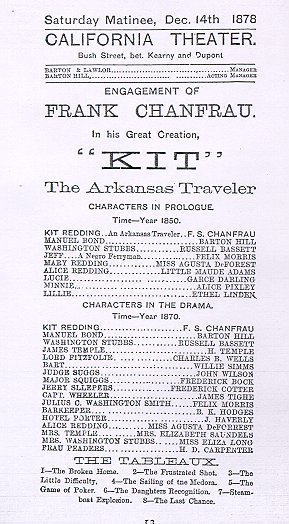
Kit, the Arkansas Traveler

Maude Adams plays "Little Alice." At the start of the play she and her mother are living in a hut on the banks of the Mississippi river. Alice Redding is arranging some flowers and the father, Kit, goes out of the hut giving his wife a horn to blow if she needs him.
The villain, Bond, appears and forces Alice and her daughter into a boat. Kit returns to the hut and sees them but it's too late for him to stop the boat. He never sees his wife again and he does not see his daughter again until she is full grown.Kit tracks the man down and eventually kills him.
One morning paper wrote of her performance:
"Little Maude Adams as the 'Alice Redding' of the Prologue, produced a lasting impression."
=====Arkansas: A Guide to the State Book; Hastings House, 1941=====
So goes part of the dialogue that accompanies one of the Nation's best known fiddle tunes, "The Arkansaw Traveler." The State's historians are generally agreed that both the story (which is narrated, not sung) and the melody were composed by Colonel Sandford C. Faulkner ( 1803-74). Faulkner, a prominent planter, is supposed to have been inspired by a conversation with a backwoodsman in 1840. A few folklore students have credited the authorship to an Ohio Valley fiddler named Jose Tasso, but Faulkner's claim was so fully recognized during his lifetime that the manager of the old St. Charles Hotel in New Orleans is said to have lettered "The Arkansas Traveler" in gilt above the door of a room reserved for him.
The vogue of the tune and dialogue spread even more widely when they were used in a play, called Kit, The Arkansas Traveler, that delighted New York audiences of the 1880's. At the time, Arkansas people felt that the play was too full of pistol shots and bowie knives to be realistic. Even today many persons slightly resent the notion that the Squatter and his cabin were ever considered typical of the State. There was no gainsaying the appeal of the tune itself, however, and fiddles still quicken to its familiar rhythm after a hundred years. A Texas composer, David Guion, has used it as the theme of a symphonie score.
|